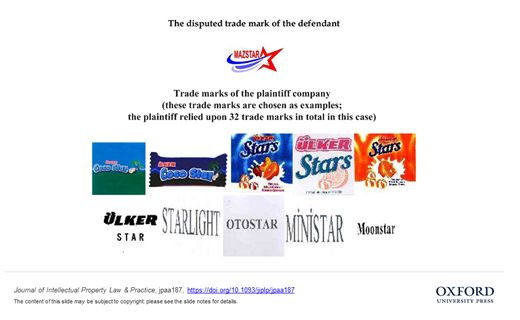The Turkish Court of Appeal (CoA) has upheld lower court decisions which ruled in favour of cancelling the Turkish Patent and Trademark Office's ('Office') Re-Examination and Evaluation Board's ('Higher Board') decision for invalidation of the 'Mazstar' trade mark on the basis of likelihood of confusion with the plaintiff's trade marks bearing the common element 'Star'.
Legal context
Article 6/1 of the Industrial Property Code (IPC) rules that 'Upon opposition, the proposed trademark shall not be registered because of its identity with or similarity to a trademark which has an earlier application date or a registered trademark and because of the identity or similarity of the goods and services covered by the trademarks there exists a likelihood of confusion on the part of the public and the likelihood of confusion includes the likelihood of association with the registered trademark or with the trademark which has an earlier application date.' This ground for relative refusal is also found to be an invalidation ground as per Article 25 of the IPC.
Facts
The defendant, Mr İbrahim Aslanyavrusu, filed an application before the Office for 'MAZSTAR' in classes 29 and 30.
The application was opposed, due to prior registrations bearing the phrase 'STAR' in classes 29 and 30, by the plaintiff company Yıldız Holding Anonim Şirketi. The Office totally rejected the opposition and appeal and Yıldız Holding Anonim Şirketi filed a cancellation action based on the likelihood of confusion between the trade marks and on the well-known status of its earlier trade marks.

Before examining the details and analysis of the case, the trade marks of the parties can be seen in the chart below:
Analysis
The court of first instance determined that the trade marks cover identical goods in classes 29 and 30, and that the main and distinctive element of the disputed trade mark is the phrase 'STAR', since the phrase 'MAZ' has no meaning in Turkish and it does not distinguish the disputed trade mark from the plaintiff's ground trade marks in any semantic, visual or aural aspects. As a result, the IP Court decided to accept the case (Ankara 2nd IP Court, Merit No: 2017/260 E., Decision No: 2018/127 K., Decision Date: 21 March 2018).
The defendant Office appealed the decision before the District Court and the appeal was rejected (20th Civil Chamber of Ankara District Court, Merit No: 2018/1087 E., Decision No: 2019/477 K., Decision Date: 18 April 2019).
The matter was finally reviewed by the Turkish Court of Appeal (CoA) upon further appeal. The 11th Civil Chamber of the CoA examined the file and upheld the decision of lower courts. Accordingly, the CoA refused the Office's appeal and approved the first instance IP Court's decision (11th Chamber of the CoA, Merit No: 2019/3006 E., Decision No: 2020/841 K., Decision Date: 03 February 2020).
Having reviewed the CoA's earlier precedents, it is clear that the CoA has upheld the likelihood of confusion arguments based on the common phrase 'STAR'.
Also, in another earlier dispute, the CoA's Assembly of Civil Chambers ruled that the application 'Blue diamond & device' is similar to earlier trade mark 'DIAMOND & device', by disregarding the weakness of the prior registered trade mark. In the said decision, the Court of Appeal ignored other additional elements (Assembly of Civil Chambers of Court Of Appeals, Merit No: 2013/11–52 E., Decision No: 2013/1416 K., Decision Date: 02 October 2019).
However, in its recent decision concerning the likelihood of confusion between the trade marks CEPMATİK and TÜRKİYE İŞ BANKASI İŞCEPMATİK, the CoA ruled that CEPMATİK—meaning 'mobile'—is a weak trade mark and the likelihood of confusion between the trade marks should be evaluated comprehensively. As a result, considering the weak distinctiveness of the CEPMATİK phrase, the CoA ruled there is no likelihood of confusion between the trademarks (11th Civil Chamber of Court Of Appeals, Merit No: 2018/5860 E., Decision No: 2019/7003 K., Decision Date: 11 November 2019).
The above-mentioned precedents show that the CoA has no established approach on evaluating the likelihood of confusion in cases where the trade marks have a common weak distinctive element.
Practical significance
The CoA's subject decision can be assessed by focusing on two aspects: (i) weak distinctiveness of the phrase 'STAR', (ii) overall assessment requirement for evaluating likelihood of confusion.
In the present case, the CoA granted protection for the plaintiff's trade marks by ignoring the weak distinctiveness of the phrase 'STAR' and without making an overall assessment by considering all the elements of the parties' trade marks.
The online system of the Office reveals 8945 trade mark records bearing the phrase 'STAR' and 1041 of them cover the goods in classes 29 and/or 30. In fact, the phrase 'STAR' has a settled meaning in Turkish and it is widely known from the Turkish consumers' perspective as well. Therefore, the decision of the CoA is questionable considering the weak distinctiveness and dilution of the phrase 'STAR', since it ruled before bearing one weak-distinctive common phrase may not be sufficient for trade marks to be confused, even if it is the main element of the trade marks concerned.
As it is stated in EUIPO Convergence Programme CP5, when trade marks have a low distinctive element in common, the comparison should be based on the non-common element. However, it would be a mistake to entirely accept that common low-distinctive elements never cause a likelihood of confusion between the trade marks, since the trade marks should be taken into account as a whole (Ilanah Fhima and Dev Gangjee, The Confusion Test in Europen Trademark Law (OUP 2019) 91–92).
As it is widely known, the overall assessment is one of the key principles of evaluating the likelihood of confusion and it is more crucial for the cases where the common element has weak distinctiveness. When evaluating the likelihood of confusion between two trade marks which include the same weak distinctive phrase, the impact of non-common elements on similarity should be considered, depending on the circumstances of every case. This approach is also adopted by the CoA.
However, for the subject matter, the CoA ignored the other word and device elements of the trademarks apart from the 'STAR' phrase. The CoA and the lower courts failed to apply the key principles discussed above. The question of why the weak distinctiveness of common element does not eliminate the likelihood of confusion should have been answered by the court in this case.
First published by Oxford University Press, in 16.02.2021
The content of this article is intended to provide a general guide to the subject matter. Specialist advice should be sought about your specific circumstances.


